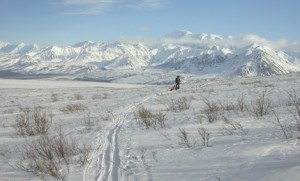Spring equinox tips the light northward
March 28, 2012
907-474-7468
3/27/2012
My thermometer here in Fairbanks is stuck on single digits today, but the height of the sun and a quick online check informs me that this is indeed the spring equinox. We will experience daylight for half the day, which was beyond imagining when the sun was two fingers above the Alaska Range in December.
In many places, including the green foothills of New York’s Adirondack Mountains where I grew up, this equinox often falls on a day that seems like spring, with warm, remembered smells of the earth and tree buds swollen to bursting. Here in the far north, we are now receiving the same daylight as New York, but our trees will not unfold their solar panels for another few months.
The Alaska’s Interior landscape is brilliant white and will be for quite some time. Our average snow melt-out date (the last consecutive day with an inch or more of snow on the ground) is April 22. The rivers, too, are quite safe for snowmachine, dogsled and ski travel; the concrete ice won’t fully rot and dissolve until mosquitoes are buzzing above it.

But things are stirring out there in the quiet world. Salmon that hatched during the darkness are emerging from riverbed gravel looking more like fish and less like eggs with eyeballs. A lucky few will embark on an amazing journey to the ocean, from where they will someday return as kings.
On south-facing hillsides, black bears that clawed into winter hibernacula last fall are still spending most of their time snoozing, undetected except for the frost around their breathing holes. Winter-born cubs pleasantly crowd their mamas, who will soon introduce the tiny bears to another world.
Wood frogs are peppered around the Alaska landscape, their tiny bodies hard as green ice cubes beneath leaves and moss and a few feet of snow that has slowed the escape of the earth’s heat. Even if a frog’s frosted brain can somehow sense the equality of day and night, its little heart will not beat again until the sun dissolves the snowpack.
While bears, frogs and insects continue their wait, the creatures that toughed out the darkness are deep in preparation for the time of no stars. Cow moose swelling with unborn calves are seeking shade from the equinox sun in the same coat that enabled them to survive January. Mother red squirrels are searching out birthing dens in trees and spruce-cone middens on the ground. Even while flying inverted in their springtime exuberance, ravens keep an eye out for sticks that will be part of nests they are building under the equinox sun.
Beneath that same sun but much closer to Antarctica, a long-beaked whimbrel is springing into the air in Chile, starting a journey north that won’t end until it reaches a familiar tundra hillside in interior Alaska. Large white swans that were the last birds to leave in October are now converging from the U.S. coastlines east and west in Alberta farm fields, fattening for a journey north.
Though the humans in Fairbanks are still plugging in their cars, there is no denying the punch of the equinox sun. Because of clear days and the reflection of the snow, solar panels in Fairbanks produce twice as much power today as they did in February, when the sun started to tickle them to life.
Today, we of the north begin enjoying longer days than beachcombers in Key West. Our bow toward the sun becomes more dramatic every day. This is proven, at least on paper, by one small but significant weather fact, tomorrow is the first day of the year that our normal low temperature in Fairbanks will not be preceded by a minus sign.
This column is provided as a public service by the Geophysical Institute at the University of Alaska Fairbanks, in cooperation with the UAF research community.


